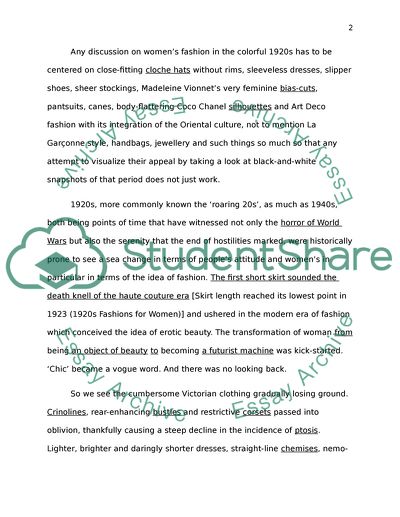Cite this document
(1920s: Womanhood Redefined Research Paper Example | Topics and Well Written Essays - 1750 words - 1, n.d.)
1920s: Womanhood Redefined Research Paper Example | Topics and Well Written Essays - 1750 words - 1. Retrieved from https://studentshare.org/culture/1752097-how-did-womens-fashions-change-in-the-1920s-have-these-styles-survived-or-ever-been-revivied-how-do-they-reflect-the-new-freedoms-many-women-were-enjoying-in-the-twenties
1920s: Womanhood Redefined Research Paper Example | Topics and Well Written Essays - 1750 words - 1. Retrieved from https://studentshare.org/culture/1752097-how-did-womens-fashions-change-in-the-1920s-have-these-styles-survived-or-ever-been-revivied-how-do-they-reflect-the-new-freedoms-many-women-were-enjoying-in-the-twenties
(1920s: Womanhood Redefined Research Paper Example | Topics and Well Written Essays - 1750 Words - 1)
1920s: Womanhood Redefined Research Paper Example | Topics and Well Written Essays - 1750 Words - 1. https://studentshare.org/culture/1752097-how-did-womens-fashions-change-in-the-1920s-have-these-styles-survived-or-ever-been-revivied-how-do-they-reflect-the-new-freedoms-many-women-were-enjoying-in-the-twenties.
1920s: Womanhood Redefined Research Paper Example | Topics and Well Written Essays - 1750 Words - 1. https://studentshare.org/culture/1752097-how-did-womens-fashions-change-in-the-1920s-have-these-styles-survived-or-ever-been-revivied-how-do-they-reflect-the-new-freedoms-many-women-were-enjoying-in-the-twenties.
“1920s: Womanhood Redefined Research Paper Example | Topics and Well Written Essays - 1750 Words - 1”, n.d. https://studentshare.org/culture/1752097-how-did-womens-fashions-change-in-the-1920s-have-these-styles-survived-or-ever-been-revivied-how-do-they-reflect-the-new-freedoms-many-women-were-enjoying-in-the-twenties.


